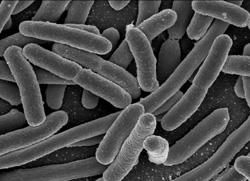a bitter spill to swallow
3 Apr 2007 by Evoluted New Media
With new biocidal product regulations and COSHH becoming ever more widespread, keeping your lab clean and safe has never been so important. Here, Ram Singh gives some top tips on beating the grime
With new biocidal product regulations and COSHH becoming ever more widespread, keeping your lab clean and safe has never been so important. Here, Ram Singh gives some top tips on beating the grime
 |
| Biocidal products that kill unwanted bacteria are vital for many biological labs - but they must be supported by the Biocidal Products Directive |
THERE is a requirement for laboratories to have adequate plans for dealing with accidents (Advisory Committee on Dangerous Pathogens, 2001), the majority of which are likely to be spills. The assessment of risk from a spill and how to negate that risk is a much wider topic than just the choice of a disinfectant to use on that spill. It will involve, amongst other things, judgement of an individual’s exposure and how to minimise hazards from that spill. Spills should be cleared either by covering with a liquid disinfectant or with absorbent disinfection granules, left for a few minutes and then carefully cleared and disposed of as contaminated waste. This procedure should then be followed up by disinfecting the area with a liquid disinfectant. If there is any risk that sharp items such as broken glass may be in the spill, scoops or an autoclavable dustpan and brush should be used to clear the disinfected spill. Small spills can be cleared by wiping the contaminated surface with a suitable disinfectant, but a wide area around the visible spill should also be treated as small splashes generated from the original spill may not be visible.
Since 1st September 2006 certain disinfectants that contain active substances - which are not supported as part of the Biocidal Products Directive
"Laboratory users need to review their current disinfectants, to ensure their use is in line with the requirements of BPR 2001" |
review programme - cannot not be placed on the EU market or stored for any purpose (except for export and disposal). The Directive is implemented in the UK as the Biocidal Products Regulations 2001 (BPR). Since 2003, industry has been aware of the need to take appropriate action to ensure a timely phase-out of stocks of products through the supply chain. Indeed, it is industry’s responsibility to ensure that all biocidal products containing unsupported active substances are removed from the EU market.
The phenolic-based Hycolin disinfectant, commonly used for inactivation of Mycobacterium tuberculosis and contaminated materials, contains active substances (including 2,4,6-trichlorophenol and Xylenol), which have not been supported as part of the biocides review and as such this formulation of Hycolin is no longer available from suppliers and manufacturers or for use. Other disinfectants (e.g. Stericol and Clearsol) have been similarly affected.
The approved codes of practice to the Control of Substances Hazardous to Health (COSHH) Regulations require that, with respect to biological agents, laboratories have specified disinfection procedures. Guidance produced by the advisory committee on dangerous pathogens (2001), a body appointed by the Health and Safety Commission, requires that there are disinfection protocols in place both for routine use and for use in spills and that workers are trained how to deal with spillages and other forms of contamination.
Mycobacterium terra was selected as the test organism to demonstrate tuberculocidal activity in EN 14348 based on extensive testing by HIRL (Hospital Infection Research Laboratory) and other eminent laboratories. Mycobacterium terrae is slightly more resistant to disinfectants than Mycobacterium tuberculosis1. Hence the minimum requirement for laboratories is to use products that have demonstrated an efficacy against Mycobacterium terrae.
If equipment may have become contaminated during use it must be decontaminated before it is serviced or repaired, either in situ or at a remote location (Medicines and Healthcare Products Regulatory Agency, 2003). A decontamination certificate should be completed for each occasion and should state either that the item was not initially contaminated, that it has been successfully decontaminated or that it cannot be decontaminated in which case advice should be given on the nature of any hazard and measures necessary to work on the equipment safely. A Virusolve+ wipe applied to a physically clean surface and which remains wet for at least one minute can be used to disinfect the surface of equipment (e.g. electrical equipment) for which immersion or soaking in disinfectant is impractical.
Loads should be sealed during centrifugation, if they are, the routine disinfection of centrifuges is not necessary. If a load is not sealed and causes contamination, then periodic disinfection will not negate any risk; the centrifuge should be modified or replaced. Disinfection may be necessary before a centrifuge is serviced or repaired, or when it is suspected that tubes may have broken or leaked during centrifugation. Following an actual or suspected breakage or leak the lid should be kept closed or rapidly reclosed on discovery of the breakage for at least 30 minutes to allow aerosols to settle. Protective gloves must be worn and forceps, or swabs held in forceps, used to pick up glass debris. Broken glass, buckets, trunnions and the rotor must be autoclaved or placed in a non-corrosive disinfectant known to be effective against the organisms concerned and approved by the centrifuge manufacturer as compatible with the centrifuge and left for at least 10-20 minutes. Unbroken, capped tubes may be placed in the disinfectant in a separate container for at least 10-20 minutes and the contents then recovered. The centrifuge bowl must be swabbed with disinfectant, left to dry, then swabbed again and finally wiped with water and dried.
Automated equipment should not disperse contamination. If it does it should be modified or replaced; periodic disinfection will not negate any risk. Surfaces that may become contaminated should be disinfected periodically, at least at the end of each day. The equipment may need disinfection before maintenance or repair.
If a spill is known or suspected, work benches should be decontaminated. Even if no contamination is suspected, small, inapparent splashes are likely to have occurred and they should be wiped with a suitable disinfectant periodically and at the end of each working day (Advisory Committee on Dangerous Pathogens, 2001).
Laboratory users need to review their current disinfectants, to ensure their use is in line with the requirements of BPR 2001. Where disinfectants do not meet these requirements, users should:
• Review the purpose for which the disinfectant is used (e.g. surface decontamination, liquid or consumable discard regimens) and whether an alternative method of inactivation is equally effective (e.g. autoclaving combined with a safe system for transport);
• Where necessary, identify an effective replacement disinfectant i.e. with demonstrated efficacy, using an approved or peer-reviewed methodology, against the pathogens (or appropriate surrogates) being used in the laboratory – this information can be obtained from manufacturers, suppliers or disinfectant testing laboratories;
• Alternative disinfectants (e.g. Virusolve+), which is purported to have efficacy of inactivation against particular pathogens (e.g. Mycobacteria spp), are used for a purpose and in a manner reflective of the efficacy test conditions used for that disinfectant;
• Where necessary, commission disinfectant efficacy testing either in-house or through a laboratory, which has the necessary expertise and experience in disinfectant testing.
Where users have existing stocks of disinfectants, which do not comply with BPR 2001, users are advised that continued use of these products for disinfection purposes is in breach of the BPR 2001 legislation and should cease. In the rare situations that laboratories cannot safely implement an alternative method of inactivation (e.g. autoclaving) and have not identified an alternative effective disinfectant, then the temporary use of the disinfectant should only be undertaken for a period sufficient to achieve this purpose. HSE as regulators in this sector will raise this issue as part of their inspections.
Where it is necessary to dispose of unused stocks of unauthorised disinfectants, the Environment Agency are best placed to advise on how this can be achieved, to ensure that there is no harm to the environment.
References
1. Griffiths et al (1998) Journal of Hospital Infection 38, 183-192 Ram Singh
Ram Singh
Ram is founding director of Amity Group consisting of Amity UK Ltd, Amity Ltd and Amity International. Amity is now represented in 68 countries around the world.






